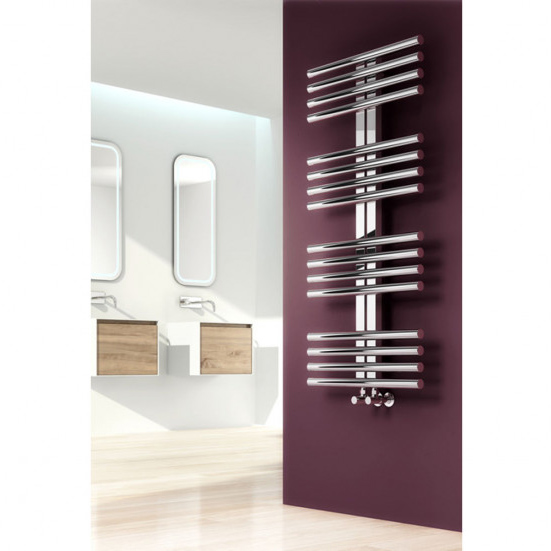Stainless Steel Radiators: The Best Eco-Friendly Heating Solution

As the chill of winter sets in, the allure of a warm, welcoming home becomes more important. In these colder months, the significance of a reliable and efficient home heating system cannot be overstated, both for the sake of comfort and for energy conservation. For a vast number of homes, the heart of warmth lies within their radiators.
These essential components work tirelessly, circulating hot water, which is heated by a boiler, to spread a consistent and cosy warmth throughout the living spaces. While old-fashioned cast iron radiators have been the norm for decades, modern stainless steel radiators offer significant advantages.
Stainless steel’s legendary corrosion resistance and durability makes it the ideal material for radiators. Supported by advanced manufacturing processes, stainless steel models from quality brands deliver reliable heating performance for over 15 years on average. This exceptional longevity far exceeds traditional cast iron or mild steel designs.
Beyond durability, stainless steel radiators provide faster warm-up times, uniform heat distribution, and easier temperature control compared to conventional options. Their sleek and streamlined aesthetics also lend a contemporary elegance perfect for today’s minimalist interiors. With so many benefits, it’s easy to see why stainless steel is becoming the #1 choice of homeowners, architects, and builders looking for modern, long-lasting, eco-friendly heating.
Why Stainless Steel is Ideal for Radiators
Stainless steel is perfectly suited for radiators due to its unique combination of properties:
Resists Corrosion: The 10-30% chromium content in stainless steel reacts with oxygen to form a thin, invisible passive layer protecting the metal from rust and corrosion. This allows it to withstand decades of water and high temperatures inside heating systems.
Handles Heat: Stainless steel maintains its strength and corrosion resistance even at extremely high temperatures above 1000°F. This high heat tolerance enables excellent heat transfer.
Good Conductivity: While lower than copper, stainless steel still conducts heat relatively well, allowing for quick warm-up of the radiator and efficient distribution of warmth.
Easy Maintenance: The smooth, non-porous surface stays free of rust and stains for years with minimal cleaning needed. It does not require repeated painting like cast iron.
Strength: Stainless steel has high strength and formability, allowing it to be pressed into radiator panels and pipes without cracking or losing shape.
Environmentally Friendly: It contains up to 85% recycled content and is 100% recyclable, making it a sustainable, eco-friendly building material.
These characteristics make stainless steel a practical and durable material for radiators. In fact, stainless steel grades like 304 or 316 are the prime choices of manufacturers today.

Stainless Steel Radiator Manufacturing Process
Specialized manufacturing processes give stainless steel radiators their superior quality and performance:
1. Sourcing Raw Material
Coils of chromium-nickel stainless steel alloys like 304, with 18% chromium and 8% nickel, are obtained. Recycled stainless steel scrap provides cost benefits and sustainability.
2. Cutting and Forming
Automated machines cut the coiled sheet to required sizes. The strips are roll formed into channel and pipe sections under pressure.
3. Assembly
The preformed steel components are TIG welded together at high temperatures. Welding creates strong, corrosion-resistant joints.
4. Testing
Stringent hydrostatic testing checks for leaks by pressurizing radiators with water well above normal levels. Finished products are also performance tested.
5. Surface Finish
Aesthetic coatings like powder painting or textured metallic finishes are applied. Some radiators get electropolished to a chrome-like mirror sheen.
6. Certification
Accredited testing agencies certify performance ratings and compliance with quality standards like EN 442 and ISO 9001.
This standardized process enables mass production of durable and efficient stainless steel radiators.
A Brief History of Stainless Steel Radiators
Let’s look at a short history of how stainless steel came into use for heating systems:
Early 1900s – Stainless steel invented
- Englishman Harry Brearley creates the first true stainless steel in 1913 while seeking a rust-proof metal.
1930s – Early residential use
- Stainless steel sees some residential use in radiators thanks to improved availability by the 1930s.
Post 1950s – Gains wider adoption
- Better welding techniques and stainless grades allow larger production, boosting adoption in the 1950s onward.
1990s – Philippe Starck designs popularize
- Starck’s avant garde stainless steel radiator designs cement it as a material that marries aesthetics and function.
Today – The preferred radiator material
- Stainless steel is now the most popular material for modern radiators due to its proven durability, efficiency and recyclability.
From humble beginnings, stainless steel has emerged as the premier choice in home and commercial heating over the past century.
Types of Stainless Steel Radiators
Stainless steel radiators come in a diverse range of configurations, sizes and styles:
The most common and classic design, column stainless steel radiators contain multiple vertical panels joined by collector tubes at top and bottom. Heat gets transferred through convection and radiation.
These compact models have two parallel panels connected by welded diaphragms in between. The “double decker” arrangement maximizes heat output from a smaller footprint.
**3. Modular Ladder Radiators **
Modular ladder design radiators get their name from horizontal heating tubes linked by vertical connectors like a ladder. Their segmented construction allows custom configurations.
Found in bathrooms and poolside locations, towel radiators have horizontal rails to dry towels and bathrobes in addition to heating.
5. Designer and Tubular Radiators
For contemporary designer looks, tubular radiators use curved and coiled stainless steel tubes. Fluid flows inside the tubes while they emit heat.
With this broad spectrum of styles and mounting options, stainless steel radiators can fit into any interior decor theme.
Comparison to Cast Iron Radiators
Let’s examine how stainless steel and old-fashioned cast iron radiators stack up against important factors:
Durability
- Stainless steel lasts 15-20 years thanks to corrosion resistance while cast iron manages 8-12 years before rusting.
Maintenance
- Stainless needs only periodic dusting while cast iron requires repainting every few years to limit rust damage.
Temperature Tolerance
- Stainless steel handles even very high heat without issue unlike cast iron which can crack.
Aesthetics
- With its modern, minimalist look, stainless steel aligns with contemporary decor preferences better.
Environmental Impact
- Stainless contains high recycled content and is fully recyclable. Cast iron recycling is more difficult.
Cost
- Stainless steel radiators have a higher upfront cost but pay back over time through lower maintenance.
Heating Performance
- Stainless steel provides up to 30% more efficient warmth than dated cast iron radiators of equal size.
With its edge across metrics from visual appeal to heating efficiency and longevity, it’s easy to see why stainless steel is now the premium radiator material.
Choosing the Right Stainless Steel Radiator
Selecting the ideal stainless steel radiator depends on factors like heat output, size, design, and budget.
Output
Firstly, the radiator must have sufficient heating capacity for the room. Output is measured in BTUs (British Thermal Units) or Watts. Too small a radiator will lead to inadequate heating.
Dimensions
Consider physical dimensions like height, width and depth based on available installation space. Measure alcoves and wall areas to ensure an optimal fit.
Design
Match the radiator’s configuration like column, ladder or double panel to your needs. Cooling and drying towel rails maybe preferred in bathrooms.
Efficiency
Look for energy-efficient models rated over 90% efficiency. Check for EN442 certification by the European Committee for Standardization.
Brand Reputation
Opt for established brands known for quality manufacturing, materials and performance. Read reviews and complaints.
Budget
Weigh costs against heating output and durability. Higher initial spend usually results in better long-term value.
Right sizing and selection ensures the radiator meets room requirements, fits the space, and aligns with interior design preferences.
Benefits of Stainless Steel Radiators
Upgrading to or installing new stainless steel radiators has several advantages:
Better Heating Efficiency
Thanks to stainless steel’s high thermal conductivity, the radiators heat up quickly and spread warmth faster while minimizing losses.
Improved Temperature Control
It’s easier to finely adjust water temperature in stainless steel radiators compared to cast iron ones, letting you maintain steady, comfortable heat.
Lower Maintenance
Stainless steel needs minimal maintenance thanks to legendary corrosion resistance. You avoid frequent repainting or repairs.
Longer Lifespan
Stainless steel radiators will easily outlast your heating system, providing 20 years or longer of trouble-free heating.
Enhanced Safety
Superior high temperature tolerance prevents warping or melting hazards. There is also no risk of rust leaks.
Hygienic
The non-porous surface won’t harbour bacteria or allergens, making stainless ideal for clinics, hospitals, and kitchens.
Aesthetic Appeal
The sleek polished or contemporary powder coated finishes add decorative flair perfect for modern interiors.
Investing in durable and reliable stainless steel radiators keeps your house cozy for decades while reducing heating expenses and environmental impact.
Popular Stainless Steel Radiator Brands
Some leading manufacturers of high-quality stainless steel radiators include:
Stelrad – One of UK’s biggest radiator brands with a vast range spanning column, ladder and vertical models.
Henrad – Offers elegant column and horizontal ladder styles combining aesthetic designs with high outputs.
Jaga – Originator of the continuous line radiator concept. Their Classix stainless models are ultra slim.
MYSON – Top British manufacturer with a reputation for reliable and efficient polished stainless steel and anthracite towel rails.
Aestus – Specializes in durable, eco-friendly radiators made from recycled stainless steel at their UK foundries.
Hudevad – Danish company renowned for minimalist Scandinavian designs and heating innovation using stainless steel.
IRSAP – Italian luxury radiator brand focused on delivering the highest quality hand-built products.
When choosing, look for established companies with strong manufacturing expertise in stainless steel.
Government Incentives for Energy-Efficient Heating
The UK government actively promotes upgrading home heating systems through policies like the Boiler Upgrade Scheme and Renewable Heat Incentive (RHI).
Boiler Upgrade Scheme
Provides grants to replace old gas boilers with more sustainable low carbon heating systems like heat pumps. It aims to reduce 600,000 tonnes of CO2 emissions.
Renewable Heat Incentive (RHI)
Offers long-term financial incentives to encourage switching from fossil fuels to renewable sources like solar water heating, biomass stoves and heat pumps.
Home Upgrade Grant (HUG)
Helps low-income households living off the gas grid to insulate homes and install energy saving upgrades. Tackling fuel poverty is the goal.
Energy Company Obligation (ECO)
Makes energy suppliers provide insulation and heating improvements to low-income and vulnerable households struggling with bills.
These schemes lower costs of upgrading to systems like stainless steel radiators combined with heat pumps, solar or underfloor heating.
Tips for Maximizing Energy Savings
Some ways to further reduce home heating expenses include:
- Add insulation in attics, basements and external walls to minimize heat loss.
- Install energy efficient double or triple glazed windows to retain more warmth.
- Ensure proper ventilation in kitchens, baths and laundries to limit moisture and prevent heat loss through evaporation.
- Use insulating drapes, blinds and curtains to provide additional insulation over windows.
- Set programmable thermostats 2-3°F lower when away or asleep without sacrificing comfort.
- Fit thermostatic radiator valves (TRVs) to shut off individual radiators when rooms are sufficiently warm.
- Service your boiler annually and bleed radiators to boost efficiency and fix issues early.
- Monitor usage with smart home systems to identify savings opportunities.
With some smart improvements and habits, homeowners can magnify energy savings from high-efficiency stainless steel radiators.
Maintaining and Caring for Stainless Steel Radiators
To keep stainless steel radiators working like new for extended periods, annual maintenance is recommended:
- Wipe down with a soft cloth and warm soapy water to remove accumulated dust and dirt.
- Open bleed valves once a year to release trapped air preventing efficient water circulation.
- Check valves, gaskets and connections for signs of leakage and replace worn parts if needed.
- Verify wall supports and mounting brackets are secure. Tighten any loose fittings.
- Confirm radiator panels and welds show no corrosion damage or leaks.
- Use a specialized stainless steel polish and microfiber cloth to remove minor scratches.
- For dents, apply auto body filler agent and touch up with suitable paint.
With periodic care, stainless steel radiators will continue delivering optimized heating performance season after season.
Conclusion
With its unmatched lifespan of over 15-20 years, excellent heat conductivity, energy efficiency, ease of maintenance, and stylish aesthetics, stainless steel has proven itself as the premier material for modern radiators. Homeowners and businesses switching to stainless steel radiators can benefit from decades of reliable warmth and drastic reductions in heating expenses.
Supported by government incentives, upgrading to stainless steel radiators coupled with heat pumps, solar collectors or biomass boilers provides an eco-friendly heating solution. As energy costs continue rising, stainless steel radiators make increasing economic and environmental sense for all types of residential and commercial buildings.



